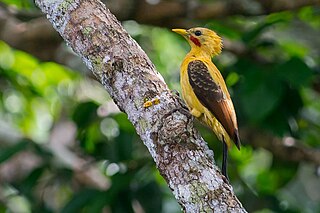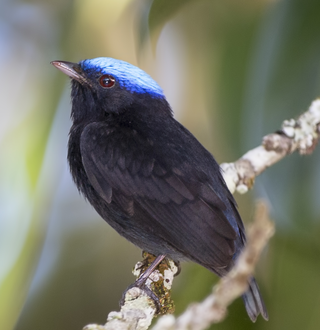
The northern shoveler, known simply in Britain as the shoveler, is a common and widespread duck. It breeds in northern areas of Europe and across the Palearctic and across most of North America, wintering in southern Europe, the Indian subcontinent, Southeast Asia, Central America, the Caribbean, and northern South America. It is a rare vagrant to Australia. In North America, it breeds along the southern edge of Hudson Bay and west of this body of water, and as far south as the Great Lakes west to Colorado, Nevada, and Oregon.

The blue-winged teal is a species of bird in the duck, goose, and swan family Anatidae. One of the smaller members of the dabbling duck group, it occurs in North America, where it breeds from southern Alaska to Nova Scotia, and south to northern Texas. It winters along the Pacific and Atlantic coasts and south into the Caribbean islands and Central America.

The garganey is a small dabbling duck. It breeds in much of Europe and across the Palearctic, but is strictly migratory, with the entire population moving to Africa, India, Bangladesh and Australasia during the winter of the Northern hemisphere, where large flocks can occur. This species was first described by Carl Linnaeus in his landmark 1758 10th edition of Systema Naturae. Like other small ducks such as the Eurasian teal, this species rises easily from the water with a fast twisting wader-like flight.

The Brazilian teal or Brazilian duck is the only duck in the genus Amazonetta. It is widely distributed in eastern South America.

The blue-billed teal, spotted teal or Hottentot teal is a species of dabbling duck of the genus Spatula. It is migratory resident in eastern and southern Africa, from Sudan and Ethiopia west to Niger and Nigeria and south to South Africa and Namibia. In west Africa and Madagascar it is sedentary.

The Puna teal is a species of dabbling duck in the family Anatidae. It was at one time regarded as a subspecies of the silver teal.

The silver teal or versicolor teal is a species of dabbling duck in the genus Spatula. It breeds in South America.

The cream-colored woodpecker is a species of bird in subfamily Picinae of the woodpecker family Picidae. It is found in every mainland South American country except Argentina, Chile, Paraguay, and Uruguay.

The wedge-billed woodcreeper is a sub-oscine passerine bird in subfamily Dendrocolaptinae of the ovenbird family Furnariidae. It is found in Mexico, Central America, Brazil, Bolivia, Ecuador, French Guiana, Guyana, Peru, Suriname, and Venezuela.

The russet antshrike is a passerine bird in subfamily Myrmornithinae of family Thamnophilidae, the "typical antbirds". It is found in Mexico, every Central American country except El Salvador, Colombia, Ecuador, Venezuela, and possibly Peru.

The dot-winged antwren or velvety antwren is a passerine bird in subfamily Thamnophilinae of family Thamnophilidae, the "typical antbirds". It is found in Mexico, every Central American country except El Salvador, Bolivia, Brazil, Colombia, Ecuador, French Guiana, Guyana, Peru, and Suriname.

The black tinamou is a species of ground bird found in humid foothill and montane forest in the Andes of South America.

The highland tinamou or Bonaparte's tinamou is a type of ground bird found in montane moist forest typically over 1,500 m (4,900 ft) altitude.

The grey-chinned hermit is a species of hummingbird in the family Trochilidae. It is found in Brazil, Colombia, Ecuador, Peru, and Venezuela.

The blue-capped manakin is a species of bird in the family Pipridae. The males have a brilliant blue cap; some have black, others have green body plumage, but the relationship between the subspecies is not well understood.

The wing-banded antbird is a species of passerine bird in subfamily Myrmornithinae of family Thamnophilidae, the "typical antbirds". It is found in Brazil, Colombia, Ecuador, French Guiana, Guyana, Nicaragua, Panama, Peru, Suriname, and Venezuela.

The white-winged becard is a species of bird in the family Tityridae. It has traditionally been placed in Cotingidae or Tyrannidae, but evidence strongly suggest it is better placed in Tityridae, where it is now placed by the South American Classification Committee. The species contains 8 subspecies that vary markedly in plumage and voice, and it has been suggested that they represent more than one species.

The white-chinned thistletail, or colicardo barbiblanco in Ecuador, is a species of bird in the Furnariinae subfamily of the ovenbird family Furnariidae. It is found in Colombia, Ecuador, Peru, and Venezuela.

The spectacled prickletail is a species of bird in the Furnariinae subfamily of the ovenbird family Furnariidae. It is found in Colombia, Ecuador, and Peru.

The blue-and-black tanager is a species of bird in the tanager family Thraupidae. It is found in the Andes of Bolivia, Colombia, Ecuador, Peru and Venezuela, where it inhabits montane evergreen forest, dwarf forest, and secondary forest at elevations of 1,500–3,500 m (4,900–11,500 ft). It inhabits the highest altitude of any Tangara species, and is the only species from the genus that is found near the tree line. Adults are 13 cm (5.1 in) long and weigh 18 g (0.63 oz) on average, and are mostly blue with black masks, wings, and tails. The species shows slight sexual dimorphism, with females being slightly duller than males.

























